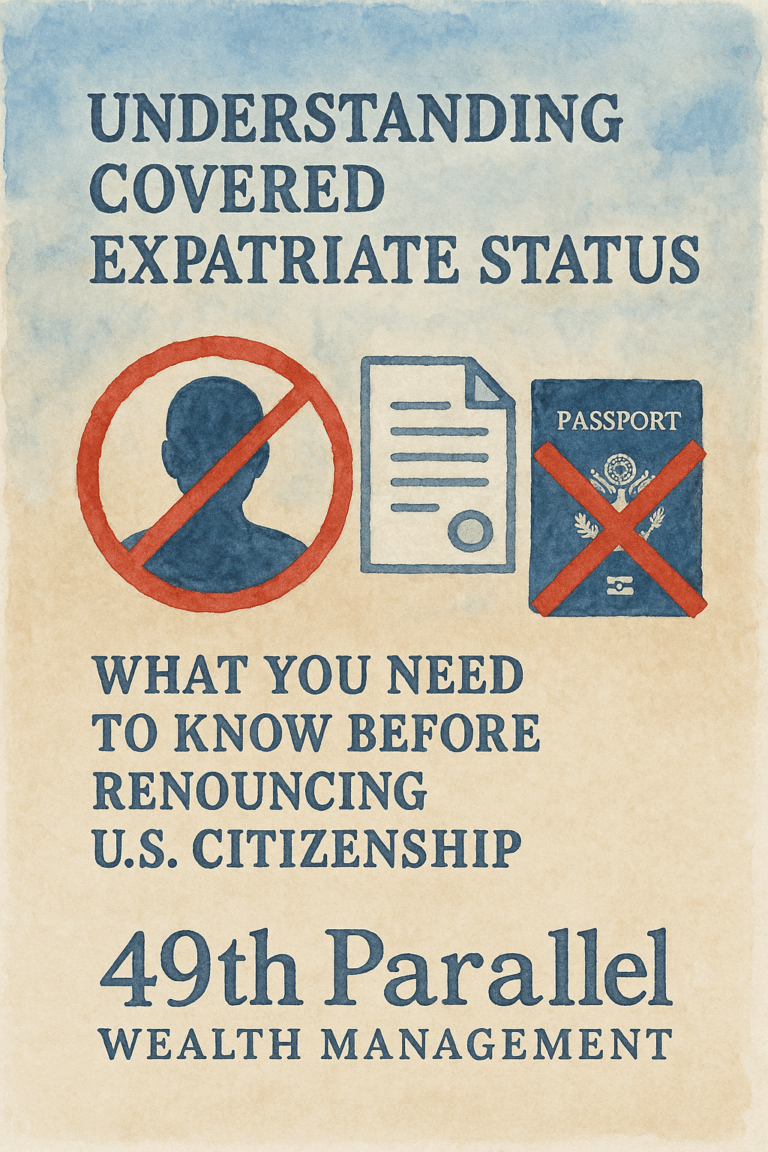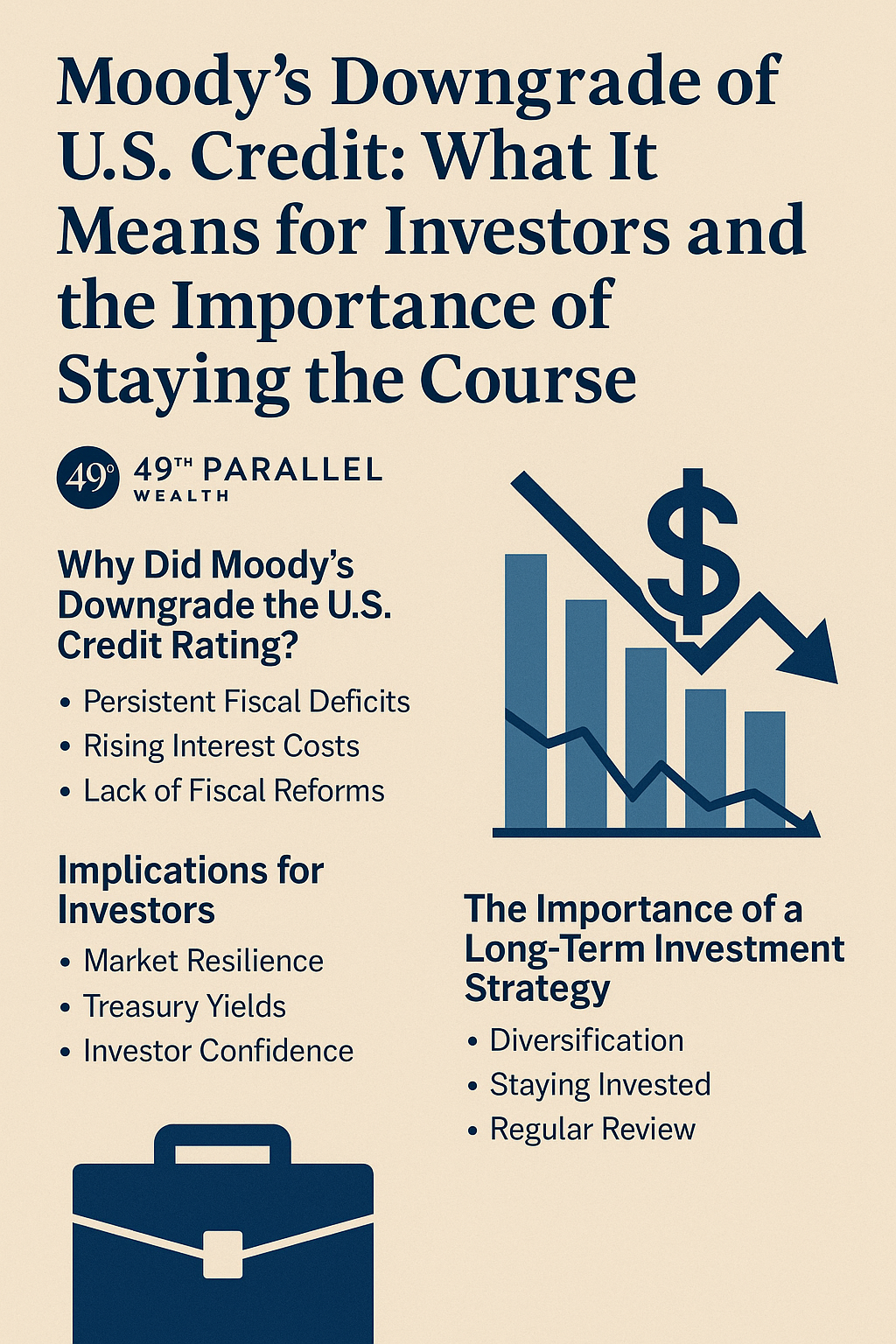Renouncing U.S. citizenship or giving up a long-held green card is a significant life decision—especially for those with meaningful assets. If you’re considering expatriation while living in Canada or abroad, it’s critical to understand whether you’ll be classified as a “Covered Expatriate” and what that means for your financial future.
The IRS imposes specific tax rules on those who renounce their U.S. status, and becoming a Covered Expatriate could trigger an exit tax, mark-to-market taxation, and serious consequences for your 401(k), 403(b), and other retirement savings.
Here’s what you need to know.
Who Is Considered a “Covered Expatriate”?
Under IRS rules (IRC §877A), you’re considered a Covered Expatriate if you have been a citizen or permanent resident for 8 of the last 15 years, and meet any one of the following three tests at the time of expatriation:
- Net Worth Test
Your net worth is $2 million USD or more on the date of expatriation.
- Tax Liability Test
Your average annual U.S. income tax liability for the five years before expatriation is $201,000 or more (2024) and $206,000 (2025).
- Certification Test (Form 8854)
You fail to certify on Form 8854 that you have complied with all U.S. federal tax obligations for the five preceding years.
What Happens If You’re a Covered Expatriate?
Covered Expatriates are subject to the Expatriation Tax, which generally treats all of your worldwide assets as if you sold them the day before your expatriation date. This “deemed disposition” triggers capital gains taxation on any unrealized gains, like what happens when you exit Canada.
Capital Gains Exemption for Covered Expatriates
Fortunately, there is an exemption amount. For 2025, the capital gains exemption is $890,000 USD (adjusted annually for inflation).
Example:
If you have $1.2 million in unrealized gains across worldwide assets, the first $890,000 is exempt. The remaining $310,000 is subject to U.S. capital gains tax rates.
Special Rules for 401(k)s and Employer Retirement Plans
Here’s where it gets tricky: Employer-sponsored retirement plans like 401(k)s can be deferred from the mark-to-market rules, but they fall under Section 877A(d), requiring regular withholding or full taxation depending on your elections.
You Have Two Options on Form 8854 (Part II, Section D, Line 1):
Option A: Elect to Defer Tax on 401(k) [Answer “Yes”]
- This defers tax on your 401(k) until you take a distribution.
- But you forfeit Canada-U.S. Tax Treaty protections.
- All future distributions will be subject to the standard 30% U.S. withholding for non-resident aliens, even if you live in Canada.
- You cannot use the Canada-U.S. Tax Treaty to receive 15% withholding in the U.S., because the treaty protection is waived.
Option B: Do Not Elect to Defer [Answer “No”]
- The entire 401(k) is treated as distributed and taxed in the year you expatriate.
- You’ll pay ordinary income tax on the full value, even though you don’t receive the funds.
- However, treaty benefits remain intact, so you may be eligible for 15% withholding as a Canadian resident.
Strategic Planning Tip: Consider Rolling to an IRA Before Expatriation
One powerful strategy to simplify and reduce your exit tax exposure is to roll your 401(k) into a Rollover IRA before expatriating.
Why?
- IRAs are U.S.-situs assets and are subject to flat withholding tax on distributions.
- If you reside in a treaty country like Canada, you’ll benefit from a reduced 15% withholding rate (Article XVIII of the Canada-U.S. Tax Treaty).
- You avoid 30% flat withholding and maintain the ability to claim a foreign tax credit in Canada.
- IRAs are not subject to mark-to-market under IRC §877A, and no immediate taxation applies if you do not defer under 877A(b).
Filing Requirements: Don’t Ignore Form 8854
Whether you’re a Covered Expatriate or not, you must file IRS Form 8854 the year you renounce your citizenship or long-term residency.
Key Focus: Part II, Section D
- Question 1: Are you electing to defer tax under section 877A(b)?
- Answering “Yes” = deferral + 30% withholding + loss of treaty
- Answering “No” = taxable now, but potentially more flexibility later
Decision Point: Should You Take the Hit Now or Later?
Before answering “Yes” or “No” on Form 8854, you need to model out the consequences.
Ask yourself:
- Will the 401(k) balance grow significantly over time?
- Do you expect to be in a lower tax bracket post-expatriation?
- Do you want to preserve treaty protections with Canada?
- Can you afford to pay U.S. income tax on the full account in your exit year?
Depending on your answers, it may make sense to:
- Roll to an IRA,
- Take partial pre-exit distributions,
- Or trigger immediate taxation strategically.
Final Thoughts: Expatriation Demands Cross-Border Expertise
Renouncing your U.S. citizenship or long-term residency is more than a political or lifesyle decision—it’s a complex financial event with permanent consequences.
Failing to understand your Covered Expatriate status or mishandling your 401(k) elections can result in:
- Unexpected taxes
- Loss of tax treaty benefits
- Double taxation of retirement accounts
- IRS penalties for noncompliance
Work With Cross-Border Experts
At 49th Parallel Wealth Management, we specialize in helping Canadians and Americans navigate the complicated web of expatriation, tax planning, and retirement optimization.
If you’re considering renouncing your U.S. citizenship or moving across the 49th Parallel, don’t go it alone.
Book a confidential consultation today to make a clear, confident, and tax-efficient transition.



